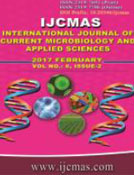


 National Academy of Agricultural Sciences (NAAS)
National Academy of Agricultural Sciences (NAAS)

|
PRINT ISSN : 2319-7692
Online ISSN : 2319-7706 Issues : 12 per year Publisher : Excellent Publishers Email : editorijcmas@gmail.com / submit@ijcmas.com Editor-in-chief: Dr.M.Prakash Index Copernicus ICV 2018: 95.39 NAAS RATING 2020: 5.38 |
Aim of the study is to evaluate the bacterial etiology of wound infections and their antimicrobial susceptibility pattern. A total of 225 consecutive, non-repeating clinical specimens from various surface wounds were collected following inclusion and exclusion criteria and processed in the Microbiology laboratory from January to June 2012, following standard methodologies. A total of 186 bacterial isolates from 142 culture positive samples which consisted of 80 gram-negative bacilli, 102 gram-positive organisms, four atypical Mycobacteria and four Candida albicans were recovered. Staphylococcus aureus was the commonest isolate (41.93%) followed by Escherichia coli (11.82%) and Pseudomonas aeruginosa (9.67%) and coagulase negative Staphylococcus (7.53%). Methicillin resistance in Staphylococcus aureus was found to be 35.9% and all gram positive isolates showed cent percent sensitivity to vancomycin. For gram-negative bacilli, amikacin was most effective drug while β-lactam drugs and ciprofloxacin showed least sensitivity. Polymyxin B emerged as most sensitive agents against Pseudomonas aeruginosa and Acinetobacter spp. The antimicrobial susceptibility pattern suggested that drug therapy for wound infections should always be guided by the sensitivity reports for effective management of surface wound infections.
 |
 |
 |
 |
 |